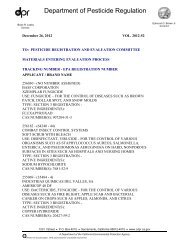Dichlorvos (DDVP) Risk Characterization Document - California ...
Dichlorvos (DDVP) Risk Characterization Document - California ...
Dichlorvos (DDVP) Risk Characterization Document - California ...
You also want an ePaper? Increase the reach of your titles
YUMPU automatically turns print PDFs into web optimized ePapers that Google loves.
Occupational Exposure<br />
The MOSs for the acute exposure of <strong>DDVP</strong> were 27, 36, and 5 for warehouse workers, PCOs, and<br />
livestock applicators, respectively (Table 23).<br />
The MOSs for non-oncogenic effects from chronic and lifetime exposures were 83 or less for workers<br />
(Table 23).<br />
The lifetime oncogenic risk for workers ranged from 6 x 10 -5 to 9 x 10 -4 .<br />
Residential Exposure<br />
The MOSs ranged from 3 to 8 for acute exposure to home fogger and no-pest strip uses (Table 23).<br />
The MOSs were 33 for adult residents after structural application and 1100 for owners of pets with flea<br />
collars.<br />
The MOS for non-oncogenic effects from chronic exposure was 4 for children after no-pest strip use<br />
(Table 23). The MOSs were 12 and 20 for children and adults after fogger use. The MOSs for<br />
chronic exposures were 125 for structural applications and 500 for pet owners. The MOSs for nononcogenic<br />
effects after lifetime exposure were 10 to 833 (Table 23).<br />
The lifetime oncogenic risk for residents ranged from 6 x 10 -6 to 1 x 10 -3 .<br />
Dietary Exposure<br />
The MOSs for acute dietary exposure of all population subgroups were greater than 300 (Table 24).<br />
Based on the DPR estimate, the MOSs for non-oncogenic effects from chronic exposure of all<br />
population subgroups, except for 1 subgroup, were greater than 100 (Table 24). The MOS was 95 for<br />
children (1-6 years). For the USEPA estimate, all MOSs were greater than 100 (Table 24).<br />
Based on DPR exposure and potency factors, the oncogenic risks for the lifetime exposure level of<br />
0.22 ug/kg-day for the U.S. population were 4 x 10 -5 and 7.7 x 10 -5 for q 1 and q 1 *, respectively. Based<br />
on the USEPA exposure estimate of 0.036 ug/kg-day and DPR potency factors, the risks were 7 x 10 -6<br />
and 1.3 x 10 -5 for q 1 and q 1 *, respectively.<br />
Combined Exposure<br />
For workers exposed to <strong>DDVP</strong> acutely at work, at home, and in the diet, the MOSs were less than 10<br />
(Table 25).<br />
The MOSs for non-oncogenic effects from chronic exposure were 12 or less for all workers (Table 25).<br />
The MOSs for non-oncogenic effects after lifetime exposure were 7 to 20 (Table 25).<br />
The lifetime oncogenic risk for residents ranged from 2 x 10 -4 to 1 x 10 -3 .<br />
71
















